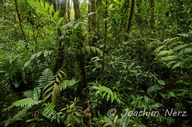|
Incilius aurarius Mendelson, Mulcahy, Snell, Acevedo & Campbell, 2012
Cuchumatan Golden Toad | family: Bufonidae genus: Incilius |
| Species Description: Mendelson III JR, Mulcahy DG, Snell S, Acevedo ME, Campbell JA. 2012. A new golden toad (Bufonidae: Incilius) from northwestern Guatemala and Chiapas, Mexico. J Herpetology 46: 473-479. | |
 © 2017 Dr. Joachim Nerz (1 of 8) |
|
|
|
Description Larval I. aurarius (based on four tadpoles of Gosner stages 32-44) have ovoid, depressed bodies widest slightly posterior to the eyes. Tail musculature is tallest at the base and gradually tapers. The oral disc is small and anteroventral. Overall, the tadpole is indistinguishable from that of I. macrocristatus (Mendelson et al. 2012). Incilius aurarius adults are similar in appearance to I. macrocristatus, but they lack the dark brown or black markings on the legs and feet that are present on the latter. They can also be distinguished by their less prominent cranial crests, the absence of vocal slits, and a characteristic golden coloration in males. Incilius aurarius males’ golden coloration is less orange than that of I. periglenes (Mendelson et al. 2012). In life, I. aurarius exhibits easily distinguishable sexual dimorphism in color pattern; females display a variable brown color with markings that are darker brown or black on the dorsum, while males are a uniform golden color that becomes paler as it approaches the ventral surface. Adult males lose the golden color when fixed in formalin and stored in ethanol. The ventral surface of males is cream-colored with faint gray mottling. The iris of the eye is copper-colored with fine black flecking. The ventral surface of females is dark brown with some light cream mottling growing more significant towards the rear of the animal, and the iris of the eye is dark brown with faint copper flecking. Formalin-fixed tadpoles have transparent ventral surfaces and uniformly red-brown dorsal and lateral surfaces. Tail musculature is similarly red-brown, and tail fins are transparent with some thin brown reticulations on the dorsal fin (Mendelson et al. 2012). Distribution and Habitat Country distribution from AmphibiaWeb's database: Guatemala, Mexico
Life History, Abundance, Activity, and Special Behaviors Trends and Threats Possible reasons for amphibian decline General habitat alteration and loss Comments The Latin aurarius means “golden”, referring to the coloration of males of this species (Mendelson et al. 2012).
References
Mendelson, III, J.R., Mulcahy, D.G. , Williams, T.S., Sites J.W. (2011). ''A phylogeny and evolutionary history of Mesoamerican toads (Anura: Bufonidae: Incilius) based on morphology, life history, and molecular data.'' Zootaxa, 3138, 1-34. Mendelson, III, J.R., Mulcahy, D.G., Snell, S., Acevedo, M.E., Campbell, J.A. (2012). ''A New Golden Toad (Bufonidae: Incilius) from Northwestern Guatemala and Chiapas, Mexico.'' Journal of Herpetology, 46(4), 473-479. Originally submitted by: Todd Pierson (first posted 2013-02-11) Edited by: Ann T. Chang (2013-02-18) Species Account Citation: AmphibiaWeb 2013 Incilius aurarius: Cuchumatan Golden Toad <https://amphibiaweb.org/species/7956> University of California, Berkeley, CA, USA. Accessed Nov 21, 2024.
Feedback or comments about this page.
Citation: AmphibiaWeb. 2024. <https://amphibiaweb.org> University of California, Berkeley, CA, USA. Accessed 21 Nov 2024. AmphibiaWeb's policy on data use. |



 Map of Life
Map of Life